Attached files
| file | filename |
|---|---|
| EX-99.1 - EX-99.1 - Day One Biopharmaceuticals, Inc. | d386415dex991.htm |
| 8-K - 8-K - Day One Biopharmaceuticals, Inc. | d386415d8k.htm |
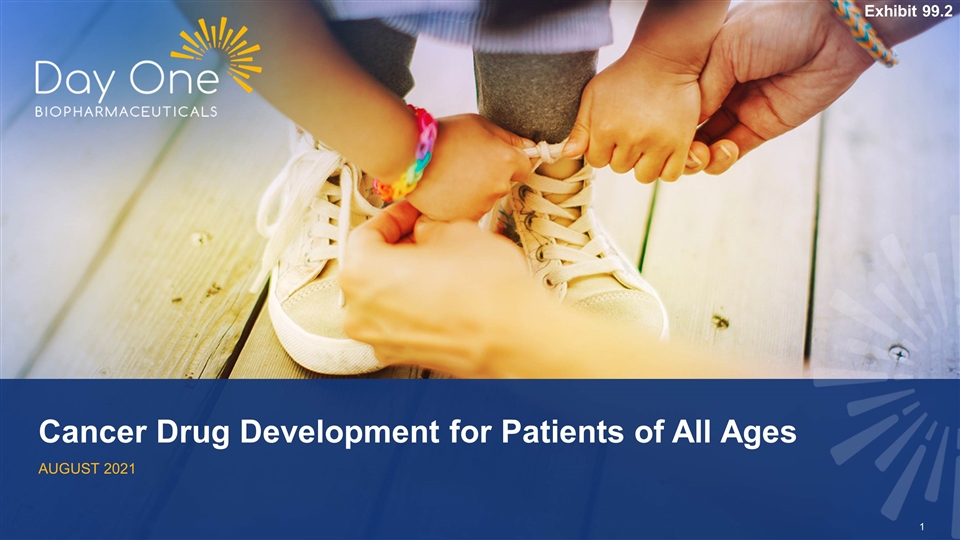
Cancer Drug Development for Patients of All Ages AUGUST 2021 Exhibit 99.2
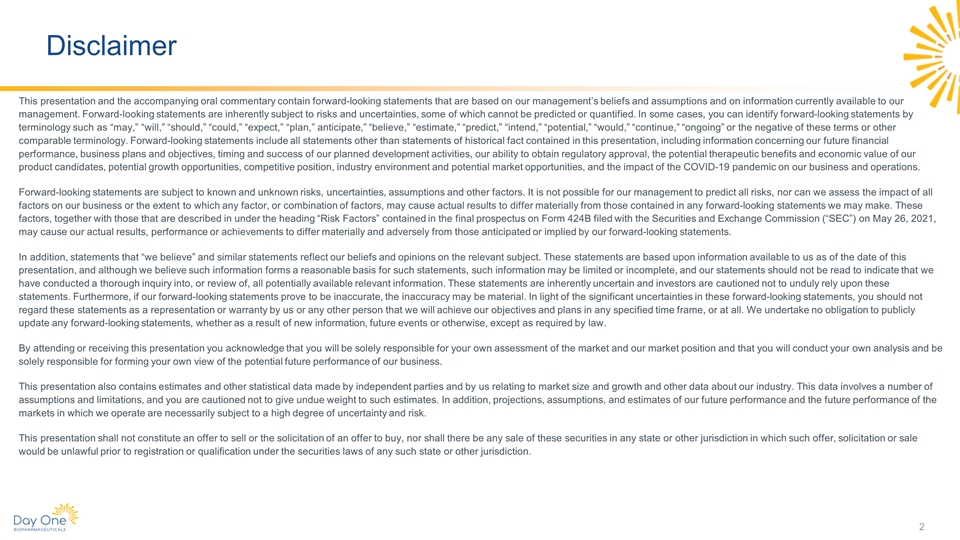
Disclaimer This presentation and the accompanying oral commentary contain forward-looking statements that are based on our management’s beliefs and assumptions and on information currently available to our management. Forward-looking statements are inherently subject to risks and uncertainties, some of which cannot be predicted or quantified. In some cases, you can identify forward-looking statements by terminology such as “may,” “will,” “should,” “could,” “expect,” “plan,” anticipate,” “believe,” “estimate,” “predict,” “intend,” “potential,” “would,” “continue,” “ongoing” or the negative of these terms or other comparable terminology. Forward-looking statements include all statements other than statements of historical fact contained in this presentation, including information concerning our future financial performance, business plans and objectives, timing and success of our planned development activities, our ability to obtain regulatory approval, the potential therapeutic benefits and economic value of our product candidates, potential growth opportunities, competitive position, industry environment and potential market opportunities, and the impact of the COVID-19 pandemic on our business and operations. Forward-looking statements are subject to known and unknown risks, uncertainties, assumptions and other factors. It is not possible for our management to predict all risks, nor can we assess the impact of all factors on our business or the extent to which any factor, or combination of factors, may cause actual results to differ materially from those contained in any forward-looking statements we may make. These factors, together with those that are described in under the heading “Risk Factors” contained in the final prospectus on Form 424B filed with the Securities and Exchange Commission (“SEC”) on May 26, 2021, may cause our actual results, performance or achievements to differ materially and adversely from those anticipated or implied by our forward-looking statements. In addition, statements that “we believe” and similar statements reflect our beliefs and opinions on the relevant subject. These statements are based upon information available to us as of the date of this presentation, and although we believe such information forms a reasonable basis for such statements, such information may be limited or incomplete, and our statements should not be read to indicate that we have conducted a thorough inquiry into, or review of, all potentially available relevant information. These statements are inherently uncertain and investors are cautioned not to unduly rely upon these statements. Furthermore, if our forward-looking statements prove to be inaccurate, the inaccuracy may be material. In light of the significant uncertainties in these forward-looking statements, you should not regard these statements as a representation or warranty by us or any other person that we will achieve our objectives and plans in any specified time frame, or at all. We undertake no obligation to publicly update any forward-looking statements, whether as a result of new information, future events or otherwise, except as required by law. By attending or receiving this presentation you acknowledge that you will be solely responsible for your own assessment of the market and our market position and that you will conduct your own analysis and be solely responsible for forming your own view of the potential future performance of our business. This presentation also contains estimates and other statistical data made by independent parties and by us relating to market size and growth and other data about our industry. This data involves a number of assumptions and limitations, and you are cautioned not to give undue weight to such estimates. In addition, projections, assumptions, and estimates of our future performance and the future performance of the markets in which we operate are necessarily subject to a high degree of uncertainty and risk. This presentation shall not constitute an offer to sell or the solicitation of an offer to buy, nor shall there be any sale of these securities in any state or other jurisdiction in which such offer, solicitation or sale would be unlawful prior to registration or qualification under the securities laws of any such state or other jurisdiction.
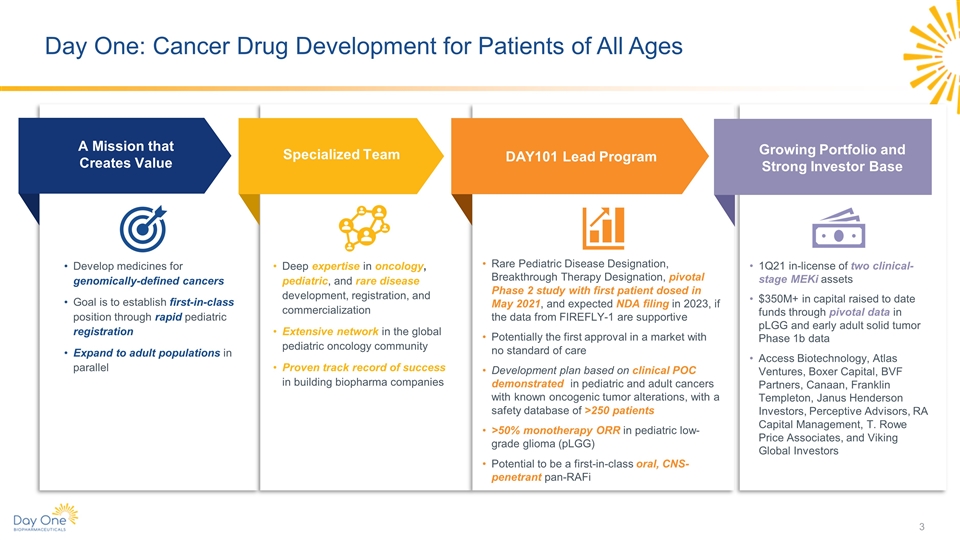
Day One: Cancer Drug Development for Patients of All Ages A Mission that Creates Value Deep expertise in oncology, pediatric, and rare disease development, registration, and commercialization Extensive network in the global pediatric oncology community Proven track record of success in building biopharma companies Specialized Team Rare Pediatric Disease Designation, Breakthrough Therapy Designation, pivotal Phase 2 study with first patient dosed in May 2021, and expected NDA filing in 2023, if the data from FIREFLY-1 are supportive Potentially the first approval in a market with no standard of care Development plan based on clinical POC demonstrated in pediatric and adult cancers with known oncogenic tumor alterations, with a safety database of >250 patients >50% monotherapy ORR in pediatric low-grade glioma (pLGG) Potential to be a first-in-class oral, CNS-penetrant pan-RAFi DAY101 Lead Program Develop medicines for genomically-defined cancers Goal is to establish first-in-class position through rapid pediatric registration Expand to adult populations in parallel 1Q21 in-license of two clinical-stage MEKi assets $350M+ in capital raised to date funds through pivotal data in pLGG and early adult solid tumor Phase 1b data Access Biotechnology, Atlas Ventures, Boxer Capital, BVF Partners, Canaan, Franklin Templeton, Janus Henderson Investors, Perceptive Advisors, RA Capital Management, T. Rowe Price Associates, and Viking Global Investors Growing Portfolio and Strong Investor Base
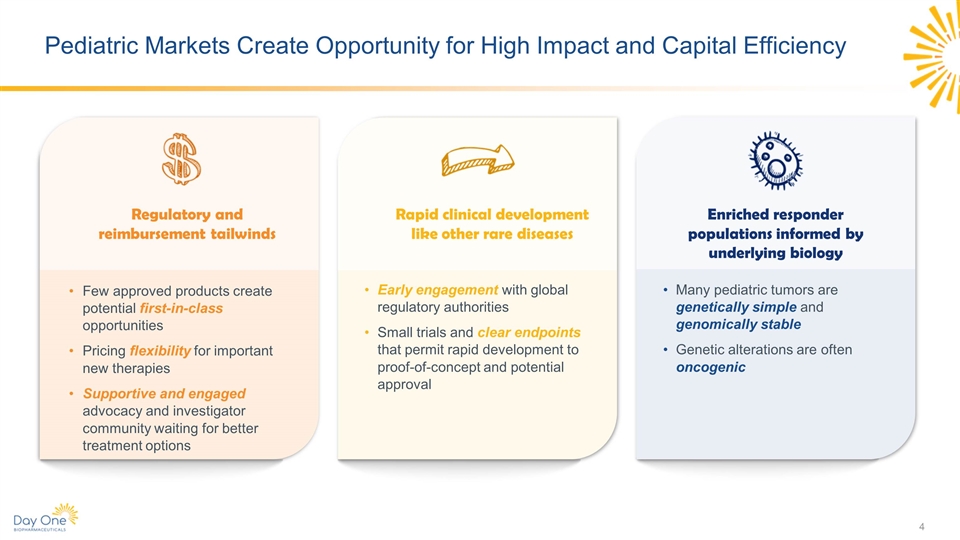
Pediatric Markets Create Opportunity for High Impact and Capital Efficiency Few approved products create potential first-in-class opportunities Pricing flexibility for important new therapies Supportive and engaged advocacy and investigator community waiting for better treatment options Early engagement with global regulatory authorities Small trials and clear endpoints that permit rapid development to proof-of-concept and potential approval Many pediatric tumors are genetically simple and genomically stable Genetic alterations are often oncogenic Rapid clinical development like other rare diseases Enriched responder populations informed by underlying biology Regulatory and reimbursement tailwinds
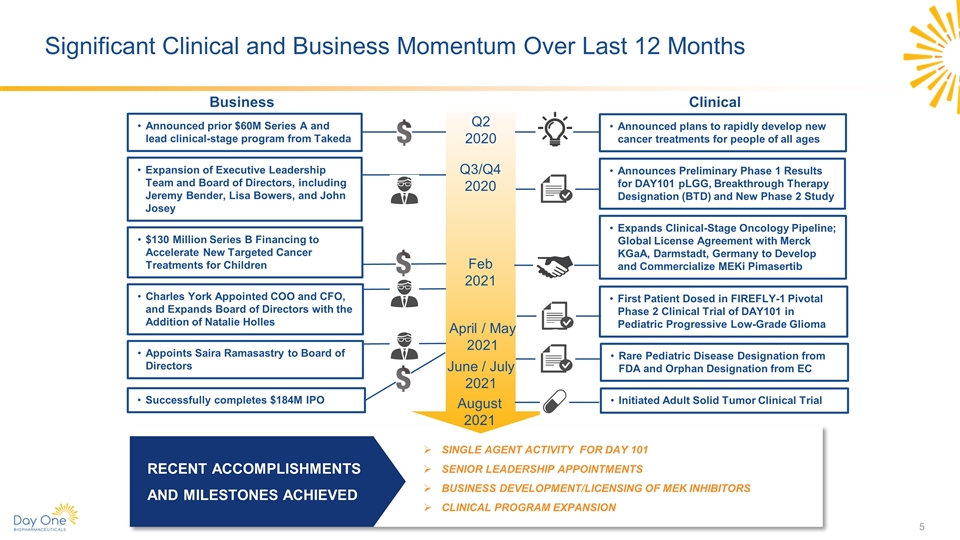
Significant Clinical and Business Momentum Over Last 12 Months SINGLE AGENT ACTIVITY FOR DAY 101 SENIOR LEADERSHIP APPOINTMENTS BUSINESS DEVELOPMENT/LICENSING OF MEK INHIBITORS CLINICAL PROGRAM EXPANSION RECENT ACCOMPLISHMENTS AND MILESTONES ACHIEVED Expansion of Executive Leadership Team and Board of Directors, including Jeremy Bender, Lisa Bowers, and John Josey Announced prior $60M Series A and lead clinical-stage program from Takeda Charles York Appointed COO and CFO, and Expands Board of Directors with the Addition of Natalie Holles $130 Million Series B Financing to Accelerate New Targeted Cancer Treatments for Children Q2 2020 Q3/Q4 2020 April / May 2021 Feb 2021 Appoints Saira Ramasastry to Board of Directors Announced plans to rapidly develop new cancer treatments for people of all ages Announces Preliminary Phase 1 Results for DAY101 pLGG, Breakthrough Therapy Designation (BTD) and New Phase 2 Study Expands Clinical-Stage Oncology Pipeline; Global License Agreement with Merck KGaA, Darmstadt, Germany to Develop and Commercialize MEKi Pimasertib First Patient Dosed in FIREFLY-1 Pivotal Phase 2 Clinical Trial of DAY101 in Pediatric Progressive Low-Grade Glioma Business Clinical Rare Pediatric Disease Designation from FDA and Orphan Designation from EC Initiated Adult Solid Tumor Clinical Trial Successfully completes $184M IPO June / July 2021 August 2021
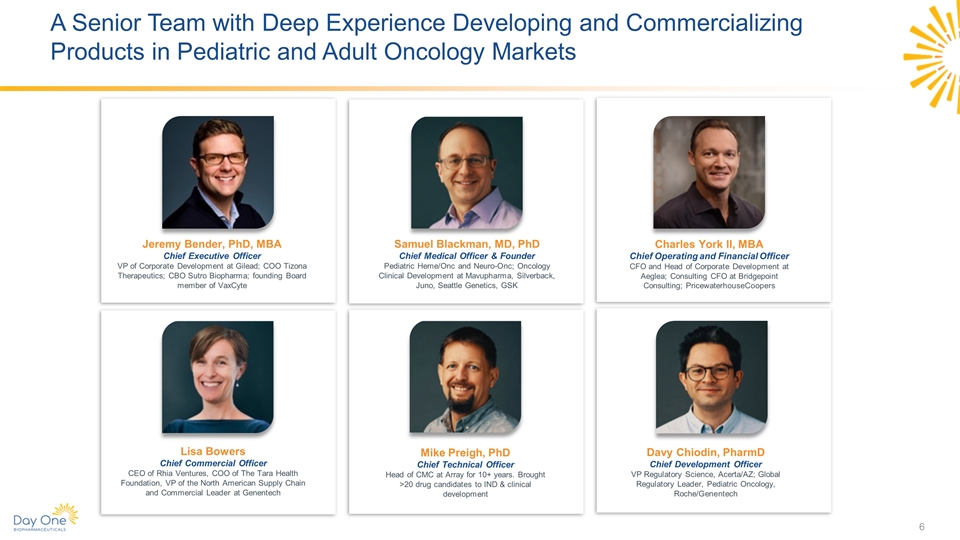
A Senior Team with Deep Experience Developing and Commercializing Products in Pediatric and Adult Oncology Markets Samuel Blackman, MD, PhD Chief Medical Officer & Founder Pediatric Heme/Onc and Neuro-Onc; Oncology Clinical Development at Mavupharma, Silverback, Juno, Seattle Genetics, GSK Lisa Bowers Chief Commercial Officer CEO of Rhia Ventures, COO of The Tara Health Foundation, VP of the North American Supply Chain and Commercial Leader at Genentech Jeremy Bender, PhD, MBA Chief Executive Officer VP of Corporate Development at Gilead; COO Tizona Therapeutics; CBO Sutro Biopharma; founding Board member of VaxCyte Davy Chiodin, PharmD Chief Development Officer VP Regulatory Science, Acerta/AZ; Global Regulatory Leader, Pediatric Oncology, Roche/Genentech Mike Preigh, PhD Chief Technical Officer Head of CMC at Array for 10+ years. Brought >20 drug candidates to IND & clinical development Charles York II, MBA Chief Operating and Financial Officer CFO and Head of Corporate Development at Aeglea; Consulting CFO at Bridgepoint Consulting; PricewaterhouseCoopers
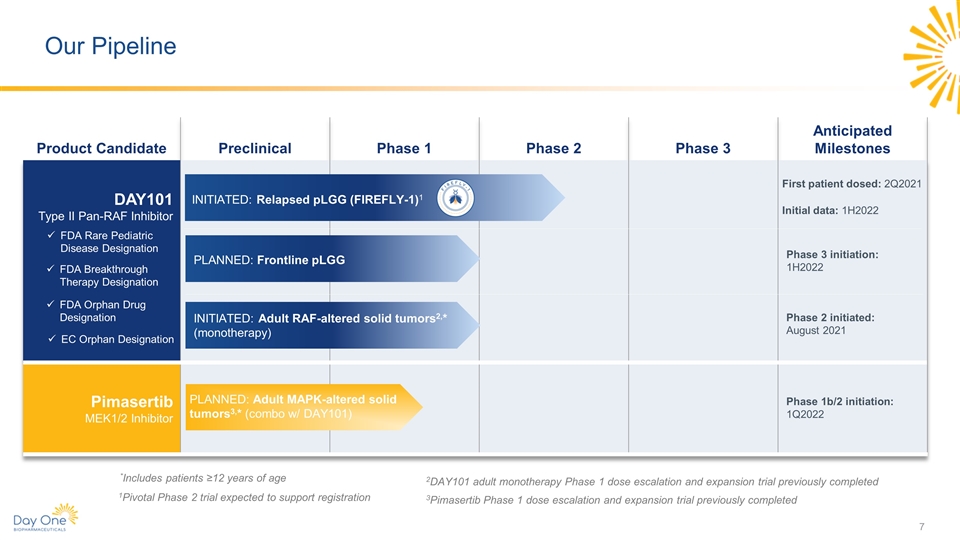
Product Candidate Preclinical Phase 1 Phase 2 Phase 3 Anticipated Milestones DAY101 Type II Pan-RAF Inhibitor Pimasertib MEK1/2 Inhibitor *Includes patients ≥12 years of age FDA Breakthrough Therapy Designation FDA Orphan Drug Designation Our Pipeline INITIATED: Relapsed pLGG (FIREFLY-1)1 PLANNED: Frontline pLGG INITIATED: Adult RAF-altered solid tumors2,* (monotherapy) PLANNED: Adult MAPK-altered solid tumors3,* (combo w/ DAY101) 1Pivotal Phase 2 trial expected to support registration 2DAY101 adult monotherapy Phase 1 dose escalation and expansion trial previously completed 3Pimasertib Phase 1 dose escalation and expansion trial previously completed First patient dosed: 2Q2021 Initial data: 1H2022 Phase 3 initiation: 1H2022 Phase 2 initiated: August 2021 Phase 1b/2 initiation: 1Q2022 EC Orphan Designation FDA Rare Pediatric Disease Designation
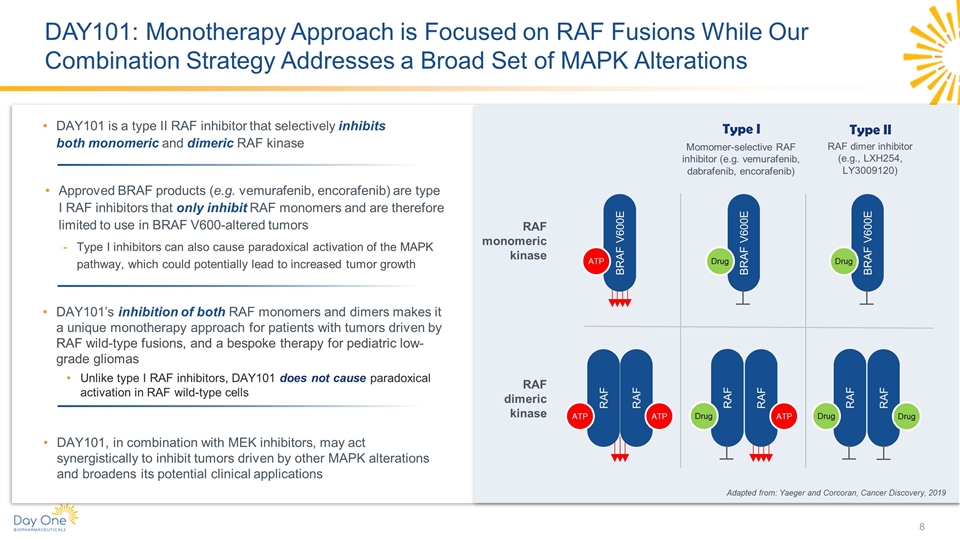
DAY101: Monotherapy Approach is Focused on RAF Fusions While Our Combination Strategy Addresses a Broad Set of MAPK Alterations DAY101 is a type II RAF inhibitor that selectively inhibits both monomeric and dimeric RAF kinase DAY101’s inhibition of both RAF monomers and dimers makes it a unique monotherapy approach for patients with tumors driven by RAF wild-type fusions, and a bespoke therapy for pediatric low-grade gliomas Unlike type I RAF inhibitors, DAY101 does not cause paradoxical activation in RAF wild-type cells Approved BRAF products (e.g. vemurafenib, encorafenib) are type I RAF inhibitors that only inhibit RAF monomers and are therefore limited to use in BRAF V600-altered tumors Type I inhibitors can also cause paradoxical activation of the MAPK pathway, which could potentially lead to increased tumor growth Adapted from: Yaeger and Corcoran, Cancer Discovery, 2019 Type I Type II BRAF V600E ATP BRAF V600E Drug BRAF V600E Drug RAF ATP RAF ATP RAF Drug RAF ATP RAF RAF Drug Drug RAF monomeric kinase RAF dimeric kinase Momomer-selective RAF inhibitor (e.g. vemurafenib, dabrafenib, encorafenib) RAF dimer inhibitor (e.g., LXH254, LY3009120) DAY101, in combination with MEK inhibitors, may act synergistically to inhibit tumors driven by other MAPK alterations and broadens its potential clinical applications
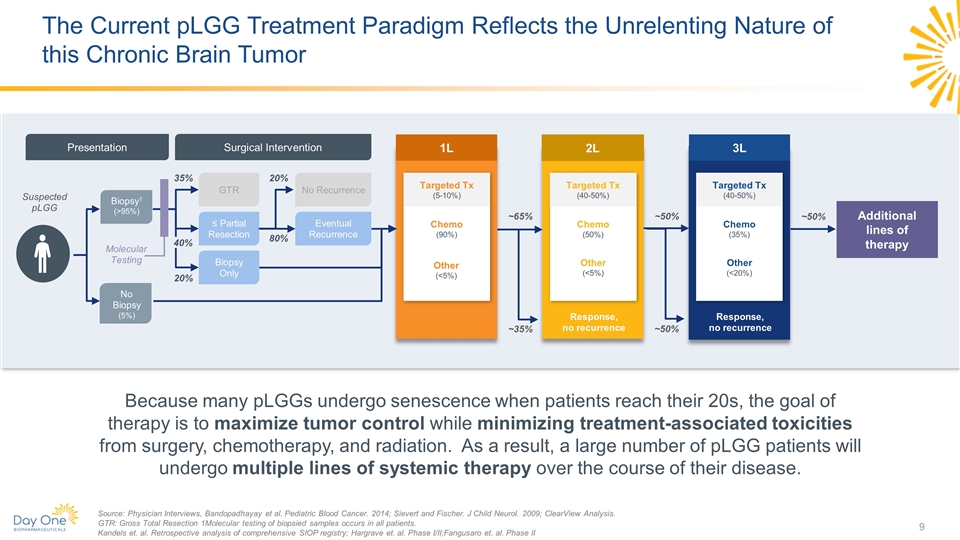
The Current pLGG Treatment Paradigm Reflects the Unrelenting Nature of this Chronic Brain Tumor CONFIDENTIAL Source: Physician Interviews, Bandopadhayay et al. Pediatric Blood Cancer. 2014; Sievert and Fischer. J Child Neurol. 2009; ClearView Analysis. GTR: Gross Total Resection 1Molecular testing of biopsied samples occurs in all patients. Kandels et. al. Retrospective analysis of comprehensive SIOP registry; Hargrave et. al. Phase I/II;Fangusaro et. al. Phase II Because many pLGGs undergo senescence when patients reach their 20s, the goal of therapy is to maximize tumor control while minimizing treatment-associated toxicities from surgery, chemotherapy, and radiation. As a result, a large number of pLGG patients will undergo multiple lines of systemic therapy over the course of their disease. Surgical Intervention Chemo (90%) Other (<5%) Targeted Tx (5-10%) Suspected pLGG GTR No Recurrence Eventual Recurrence 80% 20% 35% Presentation 1L 2L 3L Response, no recurrence ~35% Chemo (50%) Other (<5%) Targeted Tx (40-50%) Chemo (35%) Other (<20%) Targeted Tx (40-50%) Response, no recurrence ~50% ~65% ~50% Biopsy Only 40% 20% Molecular Testing Biopsy1 (>95%) No Biopsy (5%) ≤ Partial Resection ~50% Additional lines of therapy
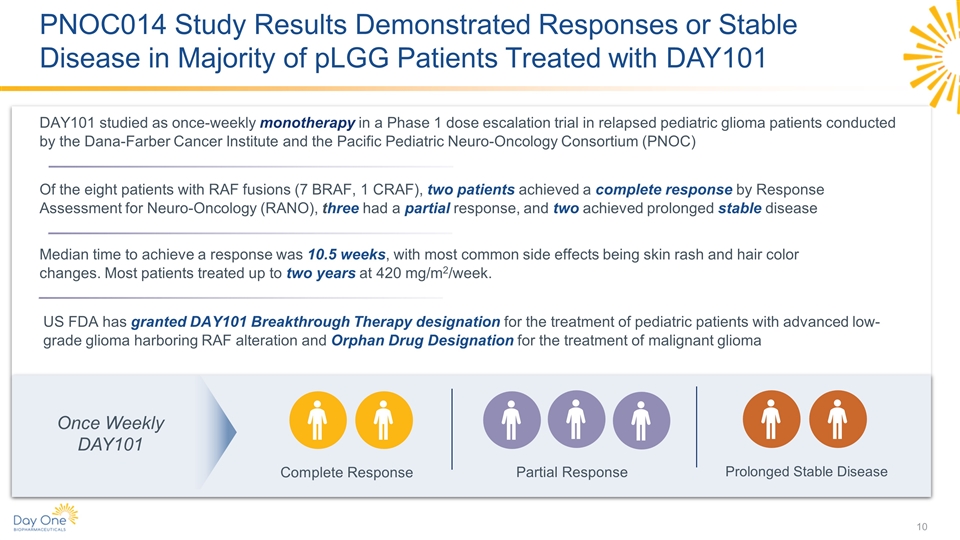
PNOC014 Study Results Demonstrated Responses or Stable Disease in Majority of pLGG Patients Treated with DAY101 Of the eight patients with RAF fusions (7 BRAF, 1 CRAF), two patients achieved a complete response by Response Assessment for Neuro-Oncology (RANO), three had a partial response, and two achieved prolonged stable disease Median time to achieve a response was 10.5 weeks, with most common side effects being skin rash and hair color changes. Most patients treated up to two years at 420 mg/m2/week. US FDA has granted DAY101 Breakthrough Therapy designation for the treatment of pediatric patients with advanced low-grade glioma harboring RAF alteration and Orphan Drug Designation for the treatment of malignant glioma DAY101 studied as once-weekly monotherapy in a Phase 1 dose escalation trial in relapsed pediatric glioma patients conducted by the Dana-Farber Cancer Institute and the Pacific Pediatric Neuro-Oncology Consortium (PNOC) Once Weekly DAY101 Complete Response Partial Response Prolonged Stable Disease
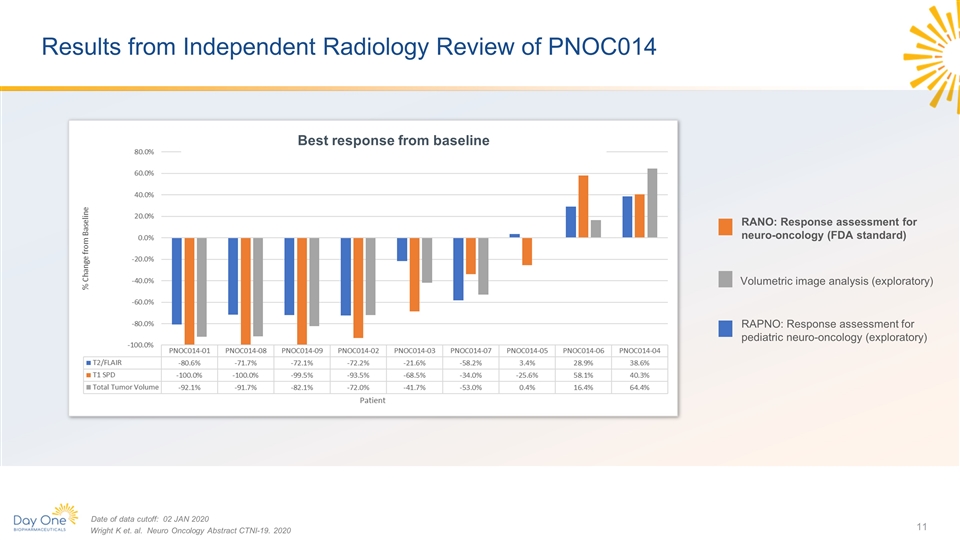
Results from Independent Radiology Review of PNOC014 % change from baseline RAPNO: Response assessment for pediatric neuro-oncology (exploratory) RANO: Response assessment for neuro-oncology (FDA standard) Volumetric image analysis (exploratory) Wright K et. al. Neuro Oncology Abstract CTNI-19. 2020 Date of data cutoff: 02 JAN 2020 Best response from baseline
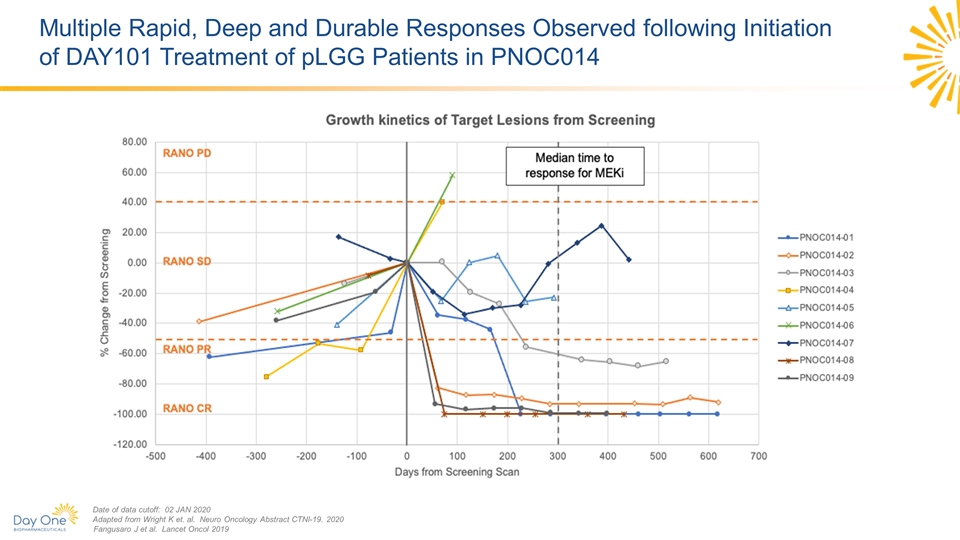
Multiple Rapid, Deep and Durable Responses Observed following Initiation of DAY101 Treatment of pLGG Patients in PNOC014 Date of data cutoff: 02 JAN 2020 Adapted from Wright K et. al. Neuro Oncology Abstract CTNI-19. 2020 Fangusaro J et al. Lancet Oncol 2019
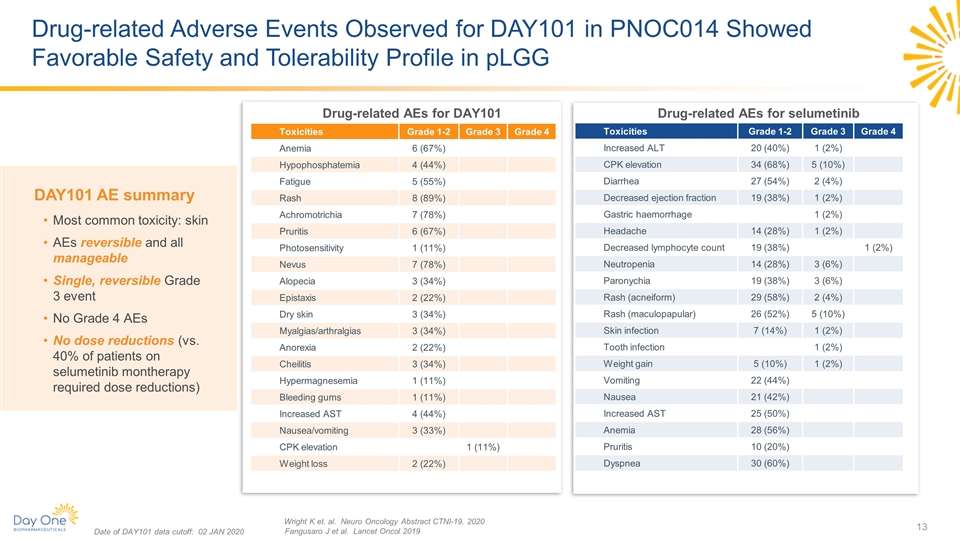
Drug-related Adverse Events Observed for DAY101 in PNOC014 Showed Favorable Safety and Tolerability Profile in pLGG Toxicities Grade 1-2 Grade 3 Grade 4 Anemia 6 (67%) Hypophosphatemia 4 (44%) Fatigue 5 (55%) Rash 8 (89%) Achromotrichia 7 (78%) Pruritis 6 (67%) Photosensitivity 1 (11%) Nevus 7 (78%) Alopecia 3 (34%) Epistaxis 2 (22%) Dry skin 3 (34%) Myalgias/arthralgias 3 (34%) Anorexia 2 (22%) Cheilitis 3 (34%) Hypermagnesemia 1 (11%) Bleeding gums 1 (11%) Increased AST 4 (44%) Nausea/vomiting 3 (33%) CPK elevation 1 (11%) Weight loss 2 (22%) DAY101 AE summary Most common toxicity: skin AEs reversible and all manageable Single, reversible Grade 3 event No Grade 4 AEs No dose reductions (vs. 40% of patients on selumetinib montherapy required dose reductions) Drug-related AEs for DAY101 Toxicities Grade 1-2 Grade 3 Grade 4 Increased ALT 20 (40%) 1 (2%) CPK elevation 34 (68%) 5 (10%) Diarrhea 27 (54%) 2 (4%) Decreased ejection fraction 19 (38%) 1 (2%) Gastric haemorrhage 1 (2%) Headache 14 (28%) 1 (2%) Decreased lymphocyte count 19 (38%) 1 (2%) Neutropenia 14 (28%) 3 (6%) Paronychia 19 (38%) 3 (6%) Rash (acneiform) 29 (58%) 2 (4%) Rash (maculopapular) 26 (52%) 5 (10%) Skin infection 7 (14%) 1 (2%) Tooth infection 1 (2%) Weight gain 5 (10%) 1 (2%) Vomiting 22 (44%) Nausea 21 (42%) Increased AST 25 (50%) Anemia 28 (56%) Pruritis 10 (20%) Dyspnea 30 (60%) Drug-related AEs for selumetinib Wright K et. al. Neuro Oncology Abstract CTNI-19. 2020 Fangusaro J et al. Lancet Oncol 2019 Date of DAY101 data cutoff: 02 JAN 2020
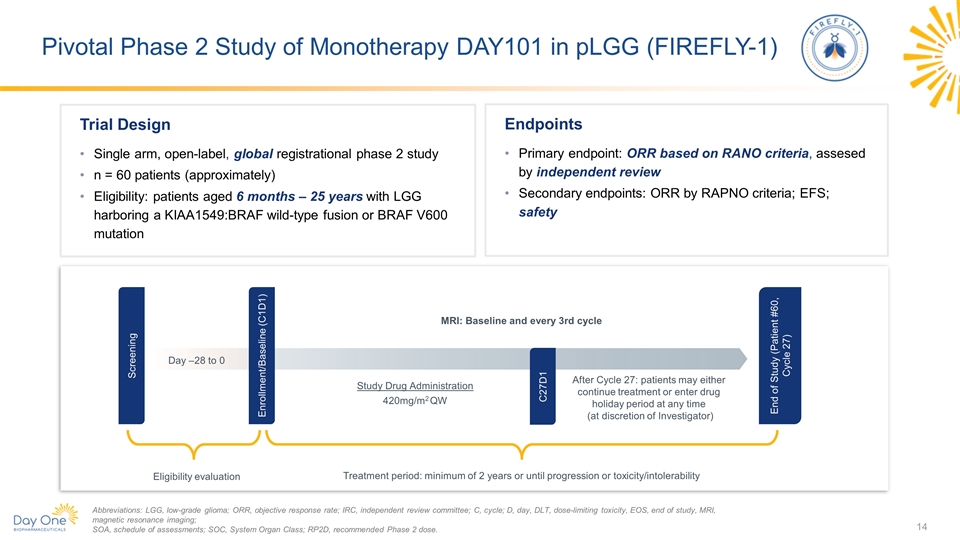
Pivotal Phase 2 Study of Monotherapy DAY101 in pLGG (FIREFLY-1) Abbreviations: LGG, low-grade glioma; ORR, objective response rate; IRC, independent review committee; C, cycle; D, day, DLT, dose-limiting toxicity, EOS, end of study, MRI, magnetic resonance imaging; SOA, schedule of assessments; SOC, System Organ Class; RP2D, recommended Phase 2 dose. Study Design Screening Day –28 to 0 Enrollment/Baseline (C1D1) MRI: Baseline and every 3rd cycle Study Drug Administration 420mg/m2 QW Eligibility evaluation Treatment period: minimum of 2 years or until progression or toxicity/intolerability C27D1 After Cycle 27: patients may either continue treatment or enter drug holiday period at any time (at discretion of Investigator) End of Study (Patient #60, Cycle 27) Trial Design Single arm, open-label, global registrational phase 2 study n = 60 patients (approximately) Eligibility: patients aged 6 months – 25 years with LGG harboring a KIAA1549:BRAF wild-type fusion or BRAF V600 mutation Endpoints Primary endpoint: ORR based on RANO criteria, assesed by independent review Secondary endpoints: ORR by RAPNO criteria; EFS; safety
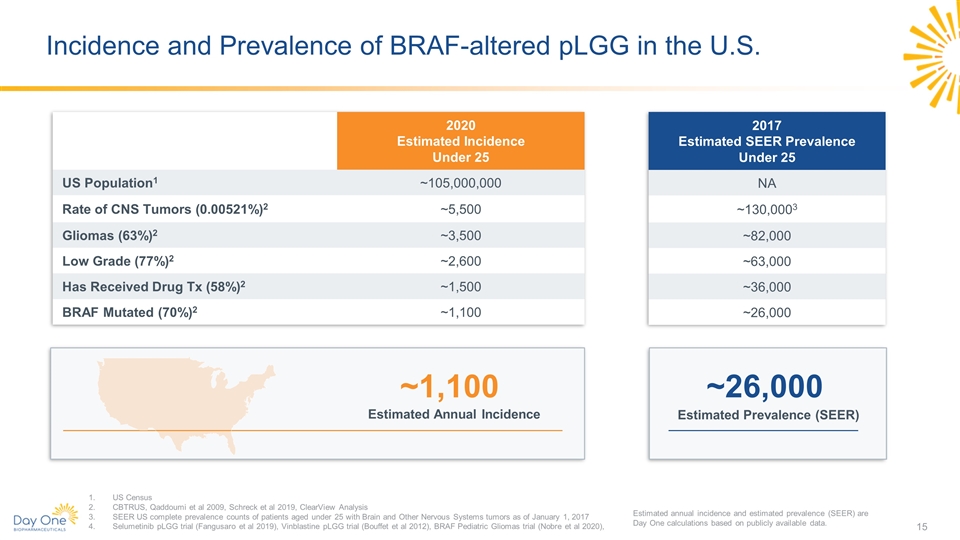
Incidence and Prevalence of BRAF-altered pLGG in the U.S. US Census CBTRUS, Qaddoumi et al 2009, Schreck et al 2019, ClearView Analysis SEER US complete prevalence counts of patients aged under 25 with Brain and Other Nervous Systems tumors as of January 1, 2017 Selumetinib pLGG trial (Fangusaro et al 2019), Vinblastine pLGG trial (Bouffet et al 2012), BRAF Pediatric Gliomas trial (Nobre et al 2020), 2020 Estimated Incidence Under 25 US Population1 ~105,000,000 Rate of CNS Tumors (0.00521%)2 ~5,500 Gliomas (63%)2 ~3,500 Low Grade (77%)2 ~2,600 Has Received Drug Tx (58%)2 ~1,500 BRAF Mutated (70%)2 ~1,100 2017 Estimated SEER Prevalence Under 25 NA ~130,0003 ~82,000 ~63,000 ~36,000 ~26,000 ~1,100 Estimated Annual Incidence ~26,000 Estimated Prevalence (SEER) Estimated annual incidence and estimated prevalence (SEER) are Day One calculations based on publicly available data.
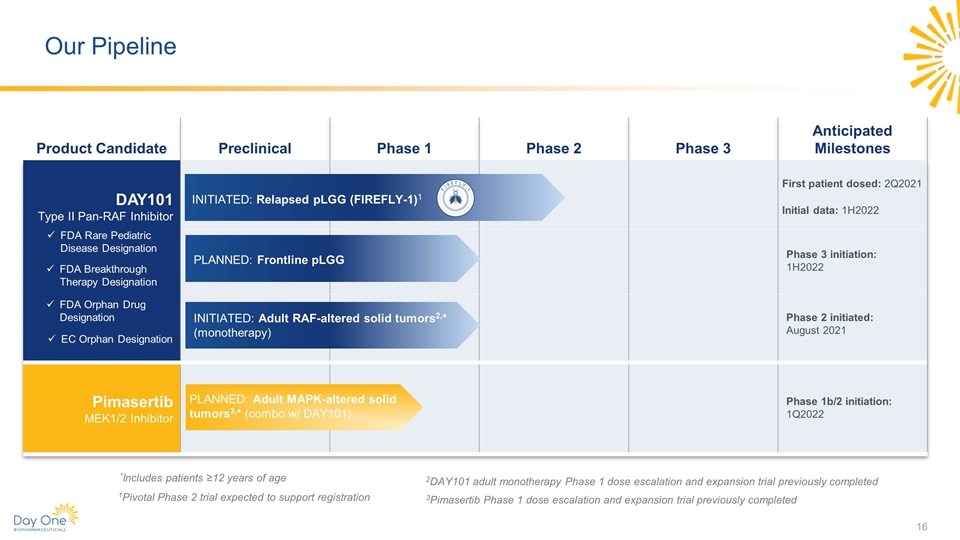
Product Candidate Preclinical Phase 1 Phase 2 Phase 3 Anticipated Milestones DAY101 Type II Pan-RAF Inhibitor Pimasertib MEK1/2 Inhibitor *Includes patients ≥12 years of age FDA Breakthrough Therapy Designation FDA Orphan Drug Designation Our Pipeline INITIATED: Relapsed pLGG (FIREFLY-1)1 PLANNED: Frontline pLGG INITIATED: Adult RAF-altered solid tumors2,* (monotherapy) PLANNED: Adult MAPK-altered solid tumors3,* (combo w/ DAY101) 1Pivotal Phase 2 trial expected to support registration 2DAY101 adult monotherapy Phase 1 dose escalation and expansion trial previously completed 3Pimasertib Phase 1 dose escalation and expansion trial previously completed First patient dosed: 2Q2021 Initial data: 1H2022 Phase 3 initiation: 1H2022 Phase 2 initiated: August 2021 Phase 1b/2 initiation: 1Q2022 EC Orphan Designation FDA Rare Pediatric Disease Designation
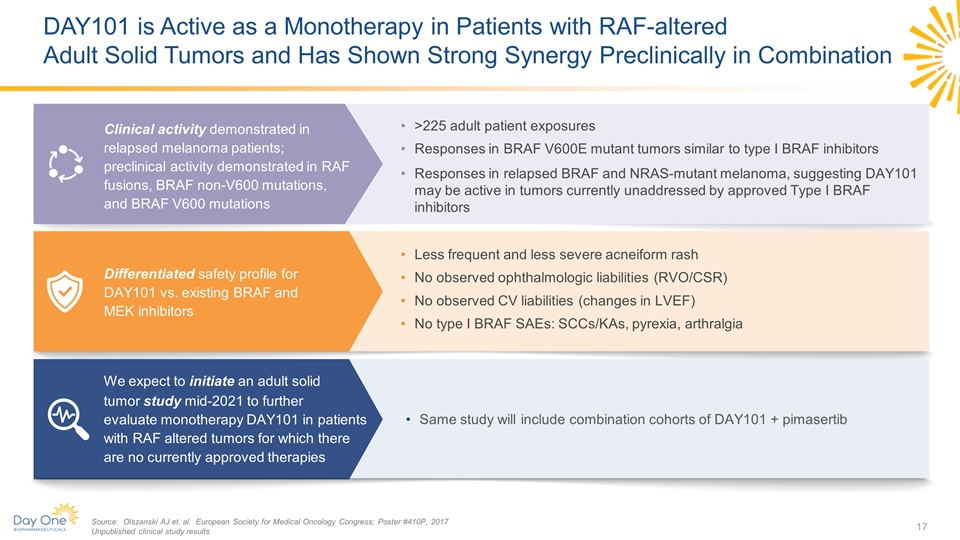
Clinical activity demonstrated in relapsed melanoma patients; preclinical activity demonstrated in RAF fusions, BRAF non-V600 mutations, and BRAF V600 mutations Source: Olszanski AJ et. al. European Society for Medical Oncology Congress; Poster #410P, 2017 Unpublished clinical study results Less frequent and less severe acneiform rash No observed ophthalmologic liabilities (RVO/CSR) No observed CV liabilities (changes in LVEF) No type I BRAF SAEs: SCCs/KAs, pyrexia, arthralgia Same study will include combination cohorts of DAY101 + pimasertib >225 adult patient exposures Responses in BRAF V600E mutant tumors similar to type I BRAF inhibitors Responses in relapsed BRAF and NRAS-mutant melanoma, suggesting DAY101 may be active in tumors currently unaddressed by approved Type I BRAF inhibitors Differentiated safety profile for DAY101 vs. existing BRAF and MEK inhibitors We expect to initiate an adult solid tumor study mid-2021 to further evaluate monotherapy DAY101 in patients with RAF altered tumors for which there are no currently approved therapies DAY101 is Active as a Monotherapy in Patients with RAF-altered Adult Solid Tumors and Has Shown Strong Synergy Preclinically in Combination
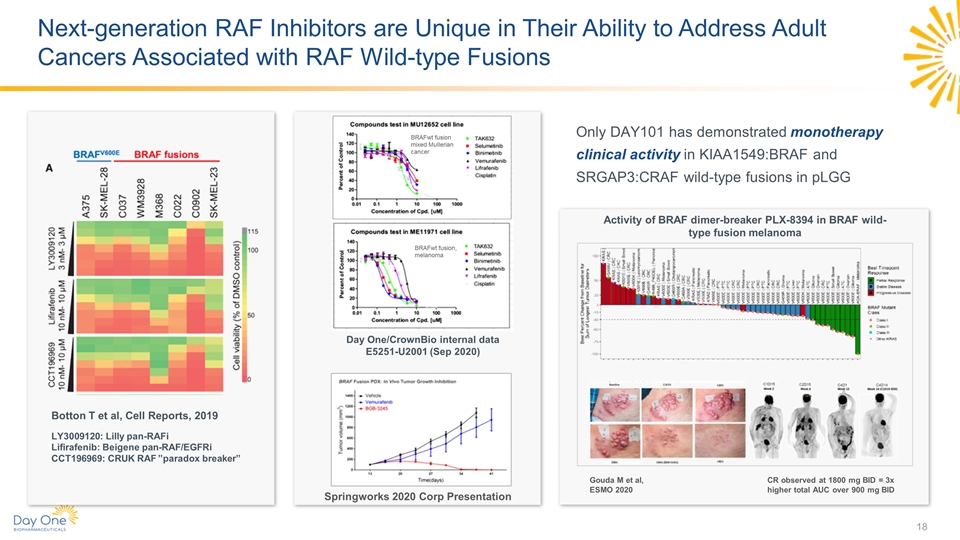
Botton T et al, Cell Reports, 2019 LY3009120: Lilly pan-RAFi Lifirafenib: Beigene pan-RAF/EGFRi CCT196969: CRUK RAF ”paradox breaker” Springworks 2020 Corp Presentation BRAFwt fusion mixed Mullerian cancer BRAFwt fusion, melanoma Day One/CrownBio internal data E5251-U2001 (Sep 2020) Only DAY101 has demonstrated monotherapy clinical activity in KIAA1549:BRAF and SRGAP3:CRAF wild-type fusions in pLGG Gouda M et al, ESMO 2020 CR observed at 1800 mg BID = 3x higher total AUC over 900 mg BID Next-generation RAF Inhibitors are Unique in Their Ability to Address Adult Cancers Associated with RAF Wild-type Fusions Activity of BRAF dimer-breaker PLX-8394 in BRAF wild-type fusion melanoma
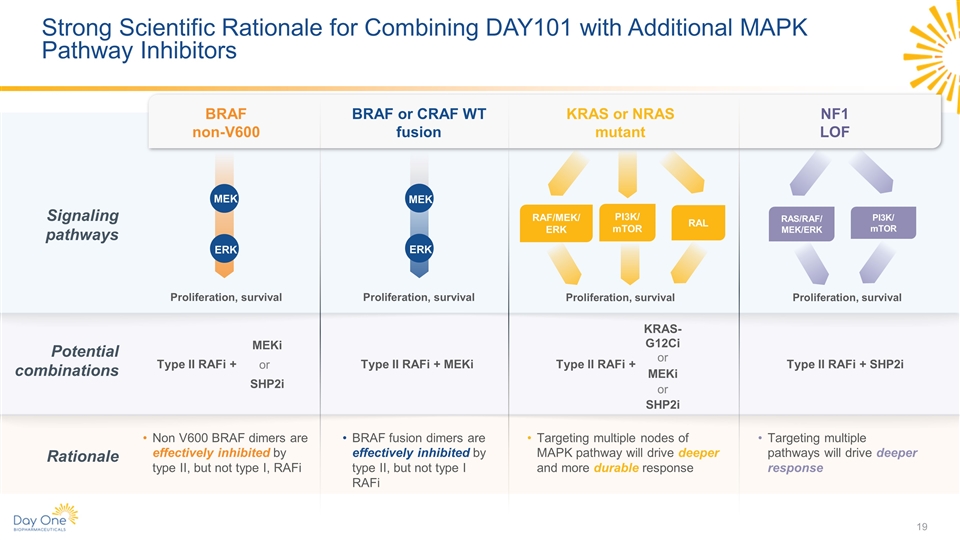
Strong Scientific Rationale for Combining DAY101 with Additional MAPK Pathway Inhibitors Potential combinations Type II RAFi + MEKi Rationale BRAF fusion dimers are effectively inhibited by type II, but not type I RAFi MEK ERK RAF/MEK/ ERK PI3K/mTOR RAL Type II RAFi + Targeting multiple nodes of MAPK pathway will drive deeper and more durable response Signaling pathways Proliferation, survival Proliferation, survival RAS/RAF/MEK/ERK PI3K/ mTOR Proliferation, survival Type II RAFi + SHP2i Targeting multiple pathways will drive deeper response Type II RAFi + Non V600 BRAF dimers are effectively inhibited by type II, but not type I, RAFi MEK ERK Proliferation, survival SHP2i MEKi or SHP2i MEKi or KRAS- G12Ci or BRAF non-V600 BRAF or CRAF WT fusion KRAS or NRAS mutant NF1 LOF
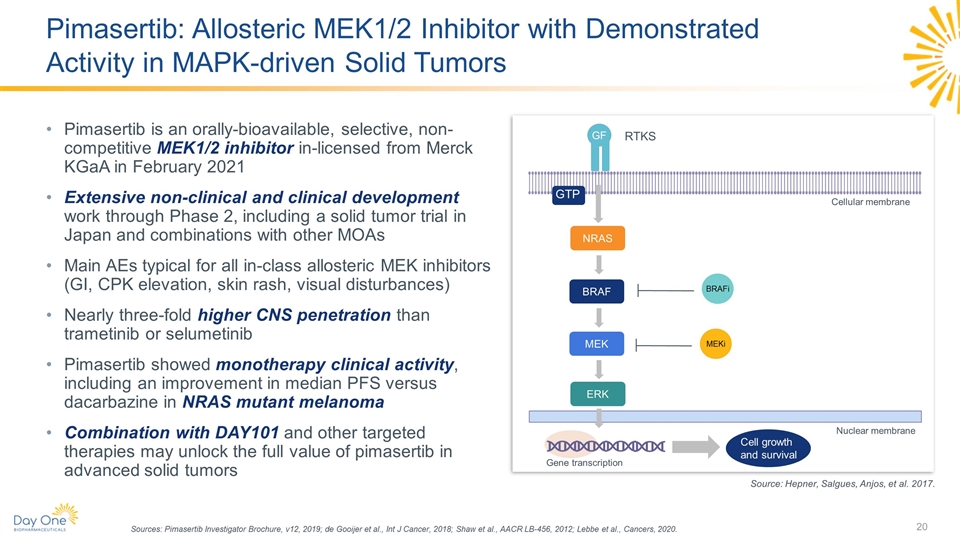
Pimasertib: Allosteric MEK1/2 Inhibitor with Demonstrated Activity in MAPK-driven Solid Tumors Sources: Pimasertib Investigator Brochure, v12, 2019; de Gooijer et al., Int J Cancer, 2018; Shaw et al., AACR LB-456, 2012; Lebbe et al., Cancers, 2020. Source: Hepner, Salgues, Anjos, et al. 2017. GF RTKS NRAS BRAF MEK ERK Cell growth and survival Nuclear membrane GTP Gene transcription Cellular membrane MEKi BRAFi Pimasertib is an orally-bioavailable, selective, non-competitive MEK1/2 inhibitor in-licensed from Merck KGaA in February 2021 Extensive non-clinical and clinical development work through Phase 2, including a solid tumor trial in Japan and combinations with other MOAs Main AEs typical for all in-class allosteric MEK inhibitors (GI, CPK elevation, skin rash, visual disturbances) Nearly three-fold higher CNS penetration than trametinib or selumetinib Pimasertib showed monotherapy clinical activity, including an improvement in median PFS versus dacarbazine in NRAS mutant melanoma Combination with DAY101 and other targeted therapies may unlock the full value of pimasertib in advanced solid tumors
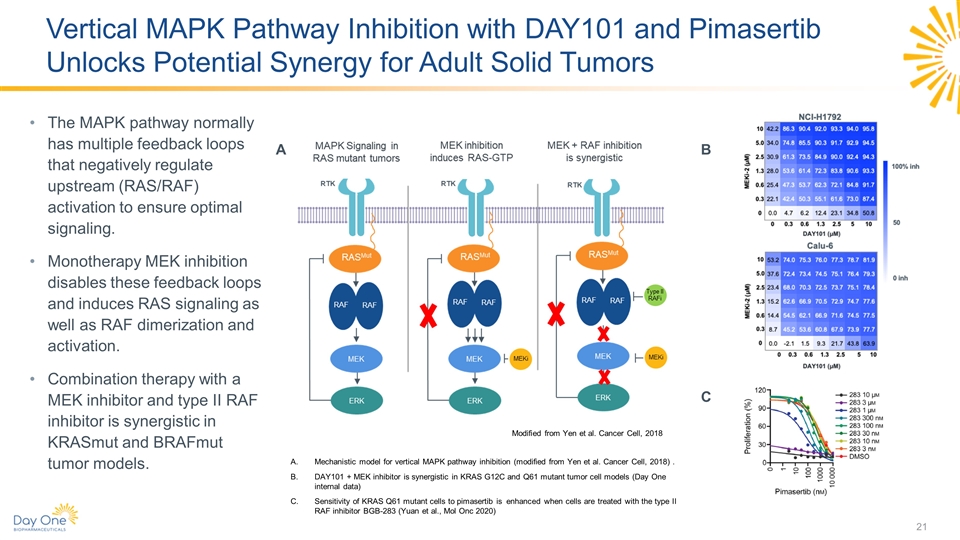
Vertical MAPK Pathway Inhibition with DAY101 and Pimasertib Unlocks Potential Synergy for Adult Solid Tumors The MAPK pathway normally has multiple feedback loops that negatively regulate upstream (RAS/RAF) activation to ensure optimal signaling. Monotherapy MEK inhibition disables these feedback loops and induces RAS signaling as well as RAF dimerization and activation. Combination therapy with a MEK inhibitor and type II RAF inhibitor is synergistic in KRASmut and BRAFmut tumor models. Modified from Yen et al. Cancer Cell, 2018 Mechanistic model for vertical MAPK pathway inhibition (modified from Yen et al. Cancer Cell, 2018) . DAY101 + MEK inhibitor is synergistic in KRAS G12C and Q61 mutant tumor cell models (Day One internal data) Sensitivity of KRAS Q61 mutant cells to pimasertib is enhanced when cells are treated with the type II RAF inhibitor BGB-283 (Yuan et al., Mol Onc 2020) A B C
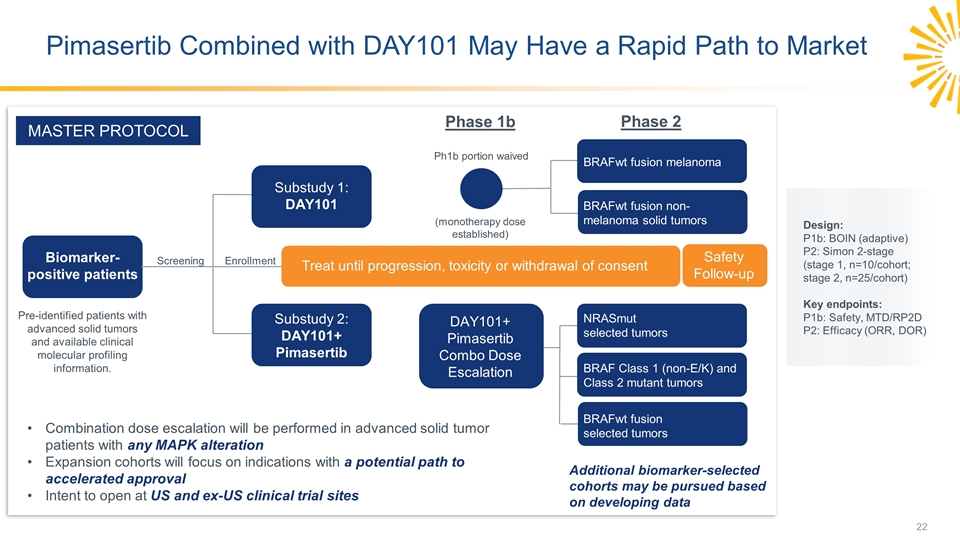
DAY101+ Pimasertib Combo Dose Escalation Pimasertib Combined with DAY101 May Have a Rapid Path to Market Biomarker-positive patients Substudy 1: DAY101 Substudy 2: DAY101+ Pimasertib Screening Enrollment Treat until progression, toxicity or withdrawal of consent Safety Follow-up BRAFwt fusion melanoma BRAFwt fusion non-melanoma solid tumors Ph1b portion waived (monotherapy dose established) NRASmut selected tumors BRAF Class 1 (non-E/K) and Class 2 mutant tumors BRAFwt fusion selected tumors Design: P1b: BOIN (adaptive) P2: Simon 2-stage (stage 1, n=10/cohort; stage 2, n=25/cohort) Key endpoints: P1b: Safety, MTD/RP2D P2: Efficacy (ORR, DOR) Combination dose escalation will be performed in advanced solid tumor patients with any MAPK alteration Expansion cohorts will focus on indications with a potential path to accelerated approval Intent to open at US and ex-US clinical trial sites Additional biomarker-selected cohorts may be pursued based on developing data Pre-identified patients with advanced solid tumors and available clinical molecular profiling information. Phase 1b Phase 2 MASTER PROTOCOL
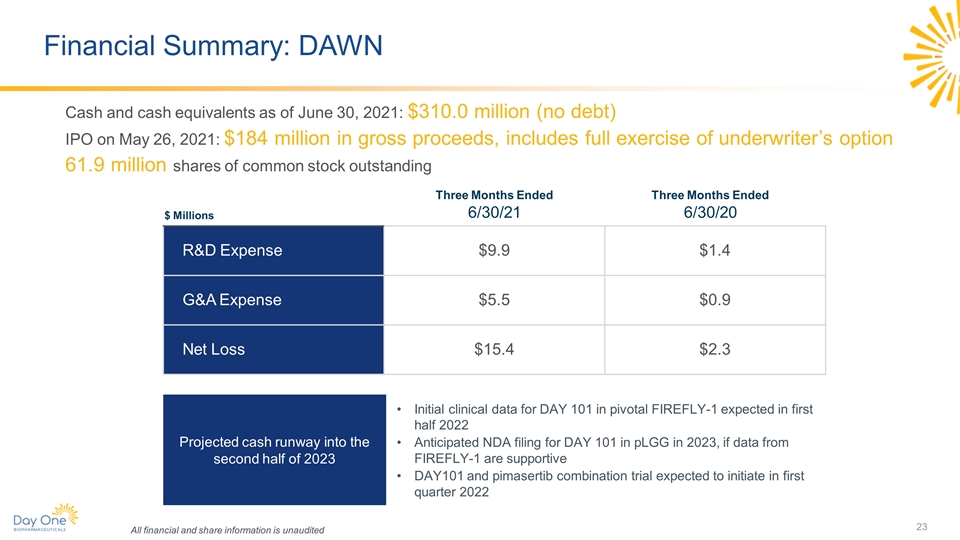
$ Millions Three Months Ended 6/30/21 Three Months Ended 6/30/20 R&D Expense $9.9 $1.4 G&A Expense $5.5 $0.9 Net Loss $15.4 $2.3 Cash and cash equivalents as of June 30, 2021: $310.0 million (no debt) IPO on May 26, 2021: $184 million in gross proceeds, includes full exercise of underwriter’s option 61.9 million shares of common stock outstanding Financial Summary: DAWN All financial and share information is unaudited Projected cash runway into the second half of 2023 Initial clinical data for DAY 101 in pivotal FIREFLY-1 expected in first half 2022 Anticipated NDA filing for DAY 101 in pLGG in 2023, if data from FIREFLY-1 are supportive DAY101 and pimasertib combination trial expected to initiate in first quarter 2022
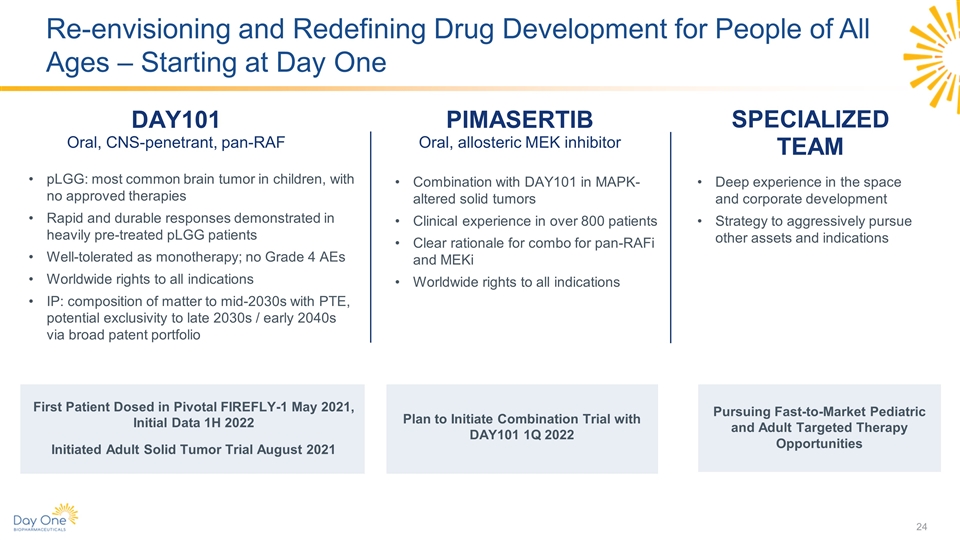
Re-envisioning and Redefining Drug Development for People of All Ages – Starting at Day One DAY101 Oral, CNS-penetrant, pan-RAF PIMASERTIB Oral, allosteric MEK inhibitor SPECIALIZED TEAM pLGG: most common brain tumor in children, with no approved therapies Rapid and durable responses demonstrated in heavily pre-treated pLGG patients Well-tolerated as monotherapy; no Grade 4 AEs Worldwide rights to all indications IP: composition of matter to mid-2030s with PTE, potential exclusivity to late 2030s / early 2040s via broad patent portfolio Combination with DAY101 in MAPK-altered solid tumors Clinical experience in over 800 patients Clear rationale for combo for pan-RAFi and MEKi Worldwide rights to all indications Deep experience in the space and corporate development Strategy to aggressively pursue other assets and indications Plan to Initiate Combination Trial with DAY101 1Q 2022 First Patient Dosed in Pivotal FIREFLY-1 May 2021, Initial Data 1H 2022 Initiated Adult Solid Tumor Trial August 2021 Pursuing Fast-to-Market Pediatric and Adult Targeted Therapy Opportunities

